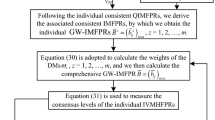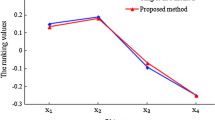Abstract
Interval-valued hesitant fuzzy preference relations (IVHFPRs) are useful that allow decision makers to apply several intervals in [0, 1] to denote the uncertain hesitation preference. To derive the reasonable ranking order from group decision making with preference relations, two topics must be considered: consistency and consensus. This paper focuses on group decision making with IVHFPRs. First, a multiplicative consistency concept for IVHFPRs is defined. Then, programming models for judging the consistency of IVHFPRs are constructed. Meanwhile, an approach for deriving the interval fuzzy priority weight vector is introduced that adopts the consistency probability distribution as basis. Subsequently, this paper builds several multiplicative consistency-based programming models for estimating the missing values in incomplete IVHFPRs. A consensus index is introduced to measure the agreement degree between individual IVHFPRs, and a method for increasing the consensus level is presented. Finally, a multiplicative consistency-and-consensus-based group decision-making method with IVHFPRs is offered, and a practical decision-making problem is selected to show the application of the new method.

Similar content being viewed by others

References
Atanassov KT (1986) Intuitionistic fuzzy sets. Fuzzy Sets Syst 20(1):87–96
Atanassov KT, Gargov G (1989) Interval valued intuitionistic fuzzy sets. Fuzzy Sets Syst 31(3):343–349
Chen N, Xu ZS, Xia MM (2013) Interval-valued hesitant preference relation relations and their applications to group decision making. Knowl-Based Syst 37:528–540
Chen N, Xu ZS, Xia MM (2013) Correlation coefficients of hesitant fuzzy sets and their applications to clustering analysis. Appl Math Modell 37:2197–2211
Gitinavard H, Mousavi SM, Vahdani B (2016) A new multi-criteria weighting and ranking model for group decision-making analysis based on interval-valued hesitant fuzzy sets to selection problems. Neural Comput Appl 27 (6):1593–1605
Gonçalves C D F, Dias JAM, Machado VAC (2015) Multi-criteria decision methodology for selecting maintenance key performance indicators. Int J Manag Sci Eng Manag 10(3):215–223
Hao ZN, Xu ZS, Zhao H, Fujita H (2017) A dynamic weight determination approach based on the intuitionistic fuzzy Bayesian network and its application to emergency decision making, IEEE Trans Fuzzy Syst. https://doi.org/10.1109/TFUZZ.2017.2755001
Jin FF, Ni ZW, Chen HY, Li YP, Zhou LG (2016) Multiple attribute group decision making based on interval-valued hesitant fuzzy information measures. Comput Ind En 101:103–115
Liao HC, Si GS, Xu ZS, Fujita H (2018) Hesitant fuzzy linguistic preference utility set and its application in selection of fire rescue plans. Int J Environ Res Public Health 15(4):1–18
Meng FY, Tan CQ (2017) Distance measures for intuitionistic hesitant fuzzy linguistic sets. Econ Comput Econ Cyber Stud Res 51(4):207–224
Meng FY, Tang J, An QX, Chen XH (2017) Decision making with intuitionistic linguistic preference relations. Int Trans Oper Res. https://doi.org/10.1111/itor.12383
Meng FY, Zhang Q, Chen XH (2017) Fuzzy multichoice games with fuzzy characteristic functions. Group Decis Negot 26(3):262–276
Meng FY, Tan CQ, Chen XH (2017) Multiplicative consistency analysis for interval reciprocal preference relations: a comparative study. Omega 68:17–38
Meng FY, Chen XH (2014) An approach to interval-valued hesitant fuzzy multi-attribute decision making with incomplete weight information based on hybrid Shapley operators. Informatica 25(4):617–642
Meng FY, Wang C, Chen XH, Zhang Q (2016) Correlation coefficients of interval-valued hesitant fuzzy sets and their application based on Shapley function. Int J Intell Syst 31(1):17–43
Meng FY, Tang J, Fujita H (2019) Linguistic intuitionistic fuzzy preference relations and their application to multi-criteria decision making. Inform Fusion 46:77–90
Ölçer I, Odabaşi A Y (2005) A new fuzzy multiple attributive group decision making methodology and its application to propulsion/ manoeuvring system selection problem. Eur J Oper Res 166(1):93–114
Pérez-Fernándeza R, Alonsob P, Bustincec H, Díazd I, Montesa S (2016) Applications of finite interval-valued hesitant fuzzy preference relations in group decision making. Inform Sci 326:89–101
Tanino T (1984) Fuzzy preference orderings in group decision making. Fuzzy Sets Syst 12(2):117–131
Tang J, An QX, Meng FY, Chen XH (2017) A natural method for ranking objects from hesitant fuzzy preference relations. Int J Inf Tech Decis Ma 16:1611–1646
Tang J, Meng FY (2017) Decision making with multiplicative hesitant fuzzy linguistic preference relations. Neural Comput Appl. https://doi.org/10.1007/s00521-017-3227-x
Torra V (2010) Hesitant fuzzy sets. Int J Intell Syst 25(6):529–539
Wang YM, Chin KS (2008) A linear goal programming priority method for fuzzy analytic hierarchy process and its applications in new product screening. Int J Approx Reason 49(2):451–465
Wang TC, Chen YH (2008) Applying fuzzy linguistic preference relations to the improvement of consistency of fuzzy AHP. Inform Sci 178(19):3755–3765
Wang H, Xu Z (2015) Some consistency measures of extended hesitant fuzzy linguistic preference relations. Inform Sci 297:316–331
Wu ZB, Xu JP (2016) Possibility distribution based approach for MAGDM with hesitant fuzzy linguistic information. IEEE Trans Cy 46(3):694–705
Wu J, Dai LF, Chiclana F, Fujita H, Herrera-Viedma E (2018) A minimum adjustment cost feedback mechanism based consensus model for group decision making under social network with distributed linguistic trust. Inform Fusion 41:232–242
Xu ZS (2001) A practical method for priority of interval number complementary judgment matrix. Oper Res Manag Sci 10(1):16–19
Xu ZS, Xia MM (2011) Distance and similarity measures for hesitant fuzzy sets. Inform Sci 181:2128–2138
Xia MM, Xu ZS (2011) Methods for fuzzy complementary preference relations based on multiplicative consistency. Comput Ind En 61(4):930–935
Xia MM, Xu ZS (2011) Hesitant fuzzy information aggregation in decision making. Int J Approx Reason 52(3):395–407
Xu YJ, Chen L, Rodríguez RM, Herrera F, Wang HM (2016) Deriving the priority weights from incomplete hesitant fuzzy preference relations in group decision making. Knowl-Based Syst 99:71–78
Yuan JH, Li CB, Xu FQ, et al. (2016) A group decision making approach in interval-valued intuitionistic hesitant fuzzy environment with confidence levels. J Intell Fuzzy Syst 31(3):1909–1919
Zadeh LA (1975) The concept of a linguistic variable and its application to approximate reasoning–Part I. Inform Sci 8(3):199–249
Zhang ZM, Wu C (2014) Deriving the priority weights from hesitant multiplicative preference relations in group decision making. Appl Soft Comput 25:107–117
Zhang ZM, Wang C (2014) A decision support model for group decision making with hesitant multiplicative preference relations. Inform Sci 68:136–166
Zhang ZM, Wang C (2014) On the use of multiplicative consistency in hesitant fuzzy linguistic preference relations. Knowl-Based Syst 72:13–27
Zhang ZM, Wang C, Tian XD (2015) A decision support model for group decision making with hesitant fuzzy preference relations. Knowl-Based Syst 86:77–101
Zhang ZM, Wang C, Tian XD (2015) Multi–criteria group decision making with incomplete hesitant fuzzy preference relations. Appl Soft Comput 36:1–23
Zhu B, Xu ZS (2014) Analytic hierarchy process-hesitant group decision making. Eur J Oper Res 239 (3):794–801
Zhu B, Xu ZS (2014) Consistency measures for hesitant fuzzy linguistic preference relations. IEEE Trans Fuzzy Syst 22(1):35–45
Zhu B, Xu ZS, Xu JP (2014) Deriving a ranking from hesitant fuzzy preference relations under group decision making. IEEE Trans Cy 44(8):1328–1337
Acknowledgments
This work was supported by the National Natural Science Foundation of China (Nos. 71571192, and 71671188), the Innovation-Driven Project of Central South University (No. 2018CX039), the Fundamental Research Funds for the Central Universities of Central South University (No. 2018zzts094), the State Key Program of National Natural Science of China (No. 71431006), and the Hunan Province Foundation for Distinguished Young Scholars of China (No. 2016JJ1024).
Author information
Authors and Affiliations
Corresponding author
Rights and permissions
About this article
Cite this article
Zhang, Y., Tang, J. & Meng, F. Programming model-based method for ranking objects from group decision making with interval-valued hesitant fuzzy preference relations. Appl Intell 49, 837–857 (2019). https://doi.org/10.1007/s10489-018-1292-1
Published:
Issue Date:
DOI: https://doi.org/10.1007/s10489-018-1292-1



